#267 Information: March 12, 1996
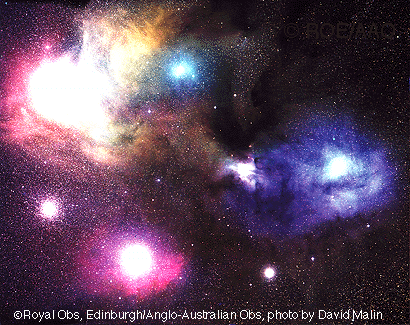
“The many spectacular colors of the Rho Ophiuchi (oh'-fee-yu-kee) clouds highlight the many processes that occur there. The blue regions shine primarily by reflected light. Blue light from the star rho Ophiuchi and nearby stars reflects more efficiently off this portion of the nebula than red light. The Earth's daytime sky appears blue for the same reason. The red and yellow regions shine primarily because of emission of the nebula's atomic and molecular gas. Light from nearby stars - particularly the bright star Antares in this case - knocks electrons away from the gas, which then shines when the electrons recombine with the gas. The dark regions are caused by dust grains - born in young stellar atmospheres - which effectively block light emitted behind them. The Rho Ophiuchi star clouds, well in front of the globular cluster M4 visible on far lower left, are even more colorful than humans can see - the clouds emits light in every wavelength band from the radio to the gamma-ray. Information: The Scale of the Universe Debate in April 1996"
Copyright: Royal Observatory, EdinburghAnglo-Australian Observatory
#268 Information: March 13, 1996
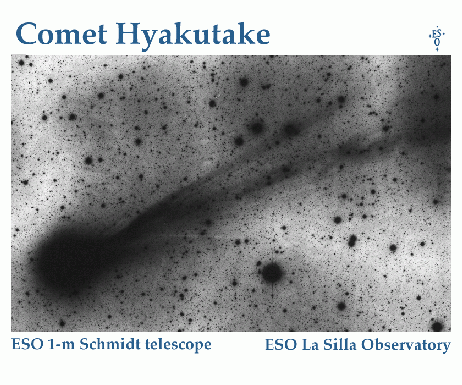
“The reaction of ancient peoples to the appearance of bright comets has toppled empires, de-throned kings, and been taken as a sign of great things to come. Probably some of these comets did not get as bright as Comet Hyakutake ("hyah-koo-tah-kay") will in the next two weeks. It is likely that every major news organization will soon cover Comet Hyakutake extensively. Comet Hyakutake is shown above already showing a tail of dust. This image, taken directly from a photographic negative, shows stars as black spots and the bright comet coma and tail as dark clouds against the white background of space. During its closest approach to the Earth on March 25th, Comet Hyakutake will appear in the Northern hemisphere as a diffuse ball of light brighter than most stars. Comet Hyakutake will be visible then most of the night even without binoculars, passing above the stars in the handle of the Big Dipper. Comet Hyakutake will be best seen in dark skies far from city lights, where its tail - possibly extending 20 degrees or more - will be most easily visible. As Comet Hyakutake recedes from the Earth it will fade, but brighten again as it nears the sun later in April. At that time it will be best seen in the southern hemisphere. There is no chance Comet Hyakutake will hit the Earth. Information: The Scale of the Universe Debate in April 1996"
Copyright: Public domain
#269 Information: March 14, 1996
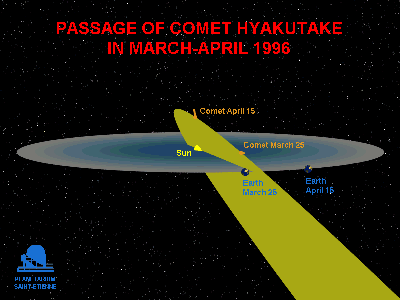
“Where did Comet Hyakutake come from? The orbits of the Earth and this brightening comet are shown in the above diagram. The blue disk is bounded by the circular orbit of the Earth about the central Sun. The comet's path outlines the green shape. The shape of the comet's orbit is close to a parabola. The comet has come in from the outer Solar System, will pass near the Earth in late March, and pass near the Sun in late April. Comet Hyakutake will appear bright in late March because it is so close to the Earth, and will again appear bright in late April because it is so close to the Sun. In late March, the comet will be "north" of the Earth and so only visible in the Northern hemisphere. Information about how to see Comet Hyakutake is available from many University astronomy departments and planetaria. Information: The Scale of the Universe Debate in April 1996"
Copyright: Public domain
#270 Information: March 15, 1996
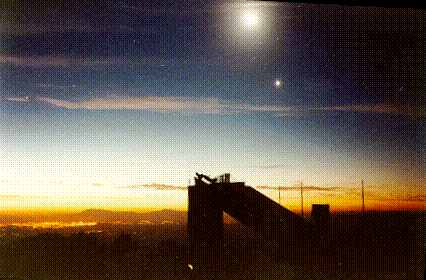
“This odd-looking structure silhouetted in the foreground houses the three largest solar telescopes in the world. Located in Kitt Peak, Arizona, the largest telescope inside the McMath-Pierce Facility is 1.6-meters in diameter and contains only mirrors. The telescope contains no windows or lenses because focusing bright sunlight would overheat them. Visible in the background of this sunrise photo are the Moon and Venus. The telescopes are used in many research projects including determining the Sun's structure, researching the cause of the solar corona, monitoring Sun-spots and solar flares, and observing bright planets and comets near the Sun. The telescopes even help monitor the Earth's atmospheric content of ozone and CFCs! Information: The Scale of the Universe Debate in April 1996"
Copyright: Bill KeelUniversity of Alabama
#271 Information: March 16, 1996

“Spiral galaxy M90 is near the center of the Virgo Cluster of Galaxies - the closest cluster of galaxies to the our own Milky Way Galaxy. Also dubbed NGC 4569, this galaxy has a very compact and bright nucleus. Because of M90's proximity and motion inside the Virgo Cluster, M90 actually shows a blueshift - indicating that it is moving toward us rather than away. Most galaxies show a redshift which indicates that they move away from us. Calibrating exactly how redshift relates to distance would indicate a scale for our universe - a topic of much debate recently. Information: The Scale of the Universe Debate in April 1996"
Copyright: Bill KeelUniversity of Alabama1.1-meter Hall Telescope,
Lowell Observatory
#272 Information: March 17, 1996
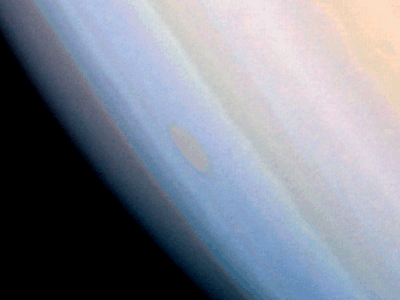
“This close-up of the tops of Saturn's clouds was taken by the Voyager 1 robot spacecraft as it passed the giant planet in November 1980. Saturn's clouds are mostly composed of hydrogen and helium gas, but the small addition of other elements gives the clouds their colors. These colors have been computer enhanced in the above photograph. Usually the clouds are divided into just bands and belt, but the center of this photograph shows the addition of a red oval cloud. The oval's origin remains a mystery, although its color indicates that its composition is slightly different than surrounding clouds. A new spacecraft - Cassini - will visit Saturn and is currently scheduled for launch in 1997. Information: The Scale of the Universe Debate in April 1996"
Copyright: Public domain
#273 Information: March 18, 1996
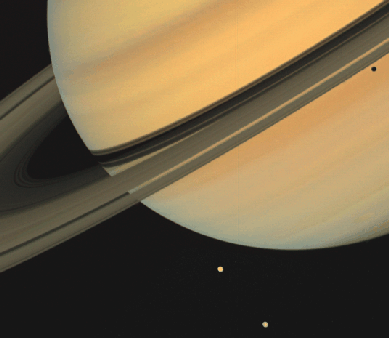
“Saturn and two of its larger moons - Tethys and Dione - were photographed by the Voyager 1 spacecraft which flew by the planet in November of 1980. This picture gives an indication of Saturn's extensive ring system, which can be seen casting a shadow on the planet, as does Tethys. Saturn's rings are composed of many chunks of ice ranging in size from a pebble to a car. The rings have several large gaps, the largest of which is clearly visible in the picture and is named the Cassini Division, after its discoverer. Saturn appears brighter than most stars in the sky, and its rings can be discerned with a small telescope. A new spacecraft - Cassini - will visit Saturn and is currently scheduled for launch in 1997. Information: The Scale of the Universe Debate in April 1996"
Copyright: Public domain
#274 Information: March 19, 1996
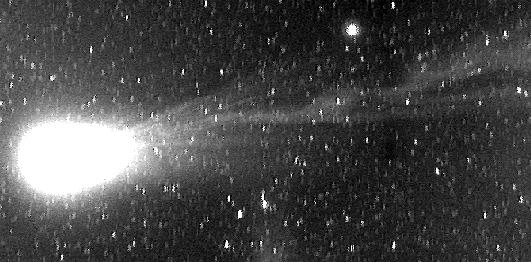
“This picture of Comet Hyakutake was taken on March 14, 1996. Structure in the ion tale of Comet Hyakutake is now clearly visible. An ion tale forms as a comet nears the Sun. Sunlight causes gas and dust to boil off the comet's solid nucleus. Charged gas - called ions - are then accelerated away from the Sun by the solar wind - fast moving particles streaming out from the Sun's corona. The ion tale will appear blue and glows by fluorescence. As Comet Hyakutake gets closer to the Sun during the next month, a dust tail is expected to be visible as well. Dust tails shine by light reflected from the Sun. Comet tails point away from the Sun, even as a comet moves away from the Sun. For observers in the Northern Hemisphere, Comet Hyakutake should appear tonight in the eastern part of the constellation of Virgo and should be about magnitude 2.5. The comet will look the most impressive in the darkest skies - in a city you are likely to see only a fuzzy blob! Information: The Scale of the Universe Debate in April 1996"
Copyright: Public domain
#275 Information: March 20, 1996
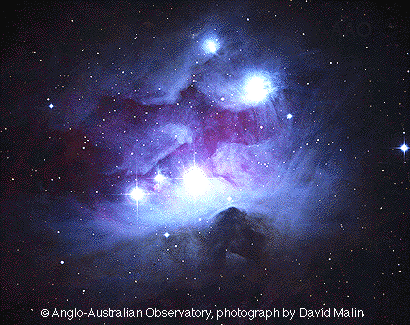
“The Orion Nebula is visible to the unaided eye as a fuzzy patch near the famous belt of three stars in the constellation Orion. The above picture captures a part of the Orion Nebula that primarily reflects light from bright Orion stars. This reflection nebula appears blue because the blue light from the neighboring stars scatters more efficiently from nebula gas than does red light. The dark lanes are composed of mostly interstellar dust - fine needle-shaped carbon grains. Information: The Scale of the Universe Debate in April 1996"
Copyright: Anglo-Australian Telescope Board
#276 Information: March 21, 1996
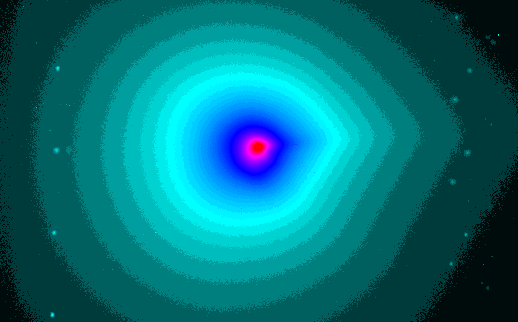
“This March 19th false-color picture of Comet Hyakutake from one of the most sophisticated ground based telescopes captures the area surrounding the comet's nucleus. A comet's nucleus - not directly visible here - is a solid dirty iceball probably no more than 10 kilometers across. This image shows, for the first time, features of irregular brightness in the coma surrounding the nucleus. The beginning of the ion tale is visible as the bright feature emanating from the right, approaching about 1000 km from nucleus. At the distance of the comet, the whole field captured here is roughly the size of the Earth. If it's clear, Comet Hyakutake may be easily visible tonight! Information: The Scale of the Universe Debate in April 1996"
Copyright: Public domain
Upvote! Resteem! Comment! As you like it! Thank you for attention!